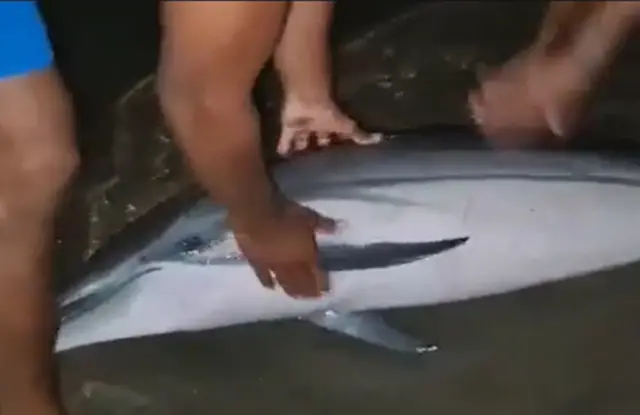The stranding of a dolphin in Playa Jacó, on the night of August 18th, was due to the agony of this marine species, the executive director of the Cetacean Research Center of Costa Rica (CEIC), Juan Diego, explained.
In a video published by the Municipality of Garabito on its social networks it is seen how residents of the community rescue the cetacean and take it back to the sea. However, the biologist indicated that these species of oceanic bottlenose dolphin separate from the group when they are sick, become disoriented and run aground on the seashore to rest and die.
“These species usually travel in herds and when they get sick they decide to leave their group. Really when they run aground in a herd it is due to some other eventuality such as territorial conflicts, oil spills or other eventualities,” said Pacheco.
Residents help the cetacean
Alfredo Espinoza, a resident of Jacó and one of the rescuers, said that the discovery occurred around 9:00 p.m. in front of their surf school, after three attempts they were able to take the animal back to the sea.
“It was disoriented, so it was difficult for us to return the dolphin to the water since the waves were quite strong. We called the Municipal Police, but when they arrived the dolphin was already gone, we could not wait long,” said Espinoza after indicating that it is the first time they see such an event. The neighbor said that this morning they returned to the beach to see if the animal had returned; however, he said it was not seen again.

Dolphins can spread diseases to humans
The executive director of the Cetacean Research Center of Costa Rica explained that dolphins can share contagious diseases with people, so manipulation of these species should be avoided.Pacheco explained that among the diseases that these species can transmit to humans are Brucellosis (similar to influenza), poxvirus, toxoplasmosis, lobomycosis, conjunctivitis, skin conditions, and viral dermatitis.
“People can see a dolphin in that condition and out of ignorance try to save it and one understands, but to have prior contact, masks and gloves or other protective objects must be put on to be able to manipulate it,” he explained.
Given these circumstances, Pacheco recommended those who had contact with this animal to monitor if they have any symptoms and go to the doctor, he also requested that they contact the authorities or the System of Conservation Areas (Sinac) on future occasions.
xperts ask people to contact authorities such as SINAC when they observe these eventualities and to avoid contact with the species


